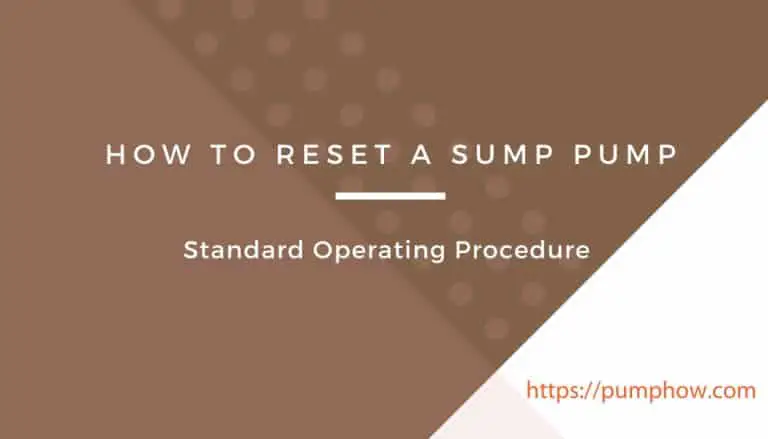If your sump pump works for a longer period of time than it’s usual runtime because there’s abundant precipitation, say 50-70 inches, you won’t want to pay much attention. What if the precipitation isn’t that high, but the pump doesn’t stop at all?
You shouldn’t rest until you find out what happened, address the problem immediately, and save the precious part of your basement waterproofing system.
A faulty float switch is the most typical cause that anyone can recognize using their common sense. But, there are other reasons which call for different measures other than fixing the switch alone.
How long do you think a sump pump can keep running? A full day or a few more hours? What then? With an ongoing or upcoming downpour, you can’t simply let the pump burn out completely and feel forced to consider a replacement.
Knowing what triggers this sump pump running constantly and how to fix it is important. In this article, you’ll learn everything about this particular condition of a sump pump and the ways to solve them.
Why Does a Sump Pump Run Constantly?

These are the most common causes for a pump to run without taking a break. Any of these is enough to wreak havoc on your sump system.
- Jammed Float Switch
- Faulty/Broken Check Valve
- Inadequate Pumping Capacity
- Wrong Size of the Basin/Liner
- Clogged/Blocked/Leaky Discharge System
- Malfunctioning Impeller
- Problem with the Foundation
- Plumbing Issues
- Location and Seasonal Factors
Now that you have the clues to the problem, you’ll find it sensible to know more about them and the right measures that may help you handle them.
Float Switch Issues
As a mechanical component, the float switch determines how the pump will respond. It works in the following two ways.
- A float that tilts upward causes the switch installed inside to turn on, which is the trigger that the pump needs to start draining.
- A float that tilts downward causes the switch to turn off sending the pump a signal that the tank has emptied and that it needs to stop. Simultaneously, the tank starts getting filled with water again.
This regular mechanism stops when the switch catches a problem and stops signaling the motor to stop. On most occasions, the switch may get tangled with a pipe or wire.
It may also become pinned to the liner’s edge. Sump pumps create vibration while running. The vibration affects the pump’s movement around the sump pit. At some point, a vibrating pump may press the switch against a side of the liner.
Under any of these circumstances, the switch fails to respond to the rise or fall of the water level. When it stays turned on and gets stuck in that position, the pump has to keep running since the switch isn’t telling it to stop.
Being in this position for a while, the switch is likely to break causing the motor to be active for an indefinite time. Lack of attention to the problem affects the motor so badly that the most familiar consequence is a burnt-out motor.
What to Do?
Assuming that you’re conscious enough to put your hands on the switch before the situation gets any worse, knowing how to fix the float switch makes sense. Take each of these steps
- Open up your sump pump to examine the switch.
- Check to see if it’s tangled. Also, see if it’s pinned against the sump liner.
- Make sure it moves smoothly with the rise and fall of the water level by freeing up or disentangling it from anything that’s keeping it stuck.
- Then, check if it’s turning the pump on or off keeping up with the water level.
It’s not surprising to see a broken or severely damaged floating switch which may not be in any position to be repaired. So, a replacement seems the only way. For this, you have to buy a new float switch, and once you do that, you have to get it in the right place.
- Disconnect the broken/damaged float switch. Remove it properly.
- Plug the new float switch in.
- Tether your switch to something. A stationary item is good enough to ensure that the switch doesn’t have a problem floating downward or upward just as the water level demands.
Note
While buying a switch, make sure it fits perfectly with your existing pump. For a confirmation of this, you should buy from the manufacturer that has exactly what’s required. Speaking of the use of a tether, you can use a rot-resistant tool or a plastic tie. Here is our guide on best float switch for a sump pump.
Check Valve Issues
A sump pump system collects water from underneath a basement to pump the water following an upward direction into a designated discharge line that runs straight for a few (5-8) feet to direct it right out of a house.
Imagine what may happen if the water in the discharge pipe falls down and get back to the pit instead of being out. The pump can’t stop because of an actively working float switch. There starts a continuous cycle of operation leading the pump to a premature burn-out eventually.
Guess what’s missing. It’s the check valve that is either absent or inoperable. The valve is designed to stop the pumped water from getting back to the sump.
What to Do?
The only solution is to replace a damaged check valve or install it if there’s none. We have an extensive guide and review on the best check valves for sump pump.
Capacity Issues (Undersized Pump)
Unless you have a sump system that operates with a manual action, it shouldn’t stop until the accumulated water is fully pumped. Most of these devices are designed to handle at least 2,000 gallons of water per hour. The number isn’t very low, but some flooding situations demand more of the pump’s capacity.
You might be wondering what exactly the size of a pump. Well, it’s not the physical size but the extent of its capacity to pump out water. If water is coming in a greater volume than what the pump can drain out, it’ll keep running to cope with the volume, and that’s when it won’t stop.
You may want to blame the manufacturers for bringing these undersized devices, but the fault isn’t entirely theirs. Your location is one of the key factors to determine how much water a sump system has to pump out on a given day during the rainy season.
There will be 27,154 and 2,715 gallons of water if there’s just 1 inch of rain and snow respectively on 1 acre of land. Now, you can calculate the volume of water your ground and its surrounding areas will receive throughout the year.
What if you live in one of the US states like Hawaii, Louisiana, Mississippi, and Alabama where the average annual rainfall can be 57.2, 56.9, 55.5, and 55.3 respectively? No doubt, you want a pump that works at 4,000 to 6,000 gallons per hour.
The situation will be far more forgiving if you’re in one of the driest states like Nevada, Arizona, Utah, New Mexico, and Wyoming. These states are known for the lowest precipitation. So, the sumps in these states don’t have to be as powerful or capable as the ones in the wettest states.
What to Do?
That said, you can use a high-capacity backup pump which is certainly something better than just letting the pump go on and on for days. Read our sump pump buying guide to get a down-to-earth idea about the right size.
Wrong Size of the Pit
It’s imperative for both the pump and the liner to be suitable for each other. With too large a liner, the pump keeps itself working to discharge water. It means the liner fills too fast and contains so much for the pump as it can’t cope up with the volume of water that needs to be removed.
On the contrary, the pump can be too powerful for the liner, which means that it discharges water faster than its liner receives water. The duration the liner takes to fill after being emptied is actually some idle time for the pump itself.
Thus, it turns on/off too frequently to make the whole thing a usual case. Besides the likelihood of a shortened lifespan, the pump goes down into short-cycling which is detrimental to its function.
What to Do?
Make sure the pump and the liner complement each other’s service, and having the pit sized according to the capacity of the pump is the only effective way. Make sure it has just the right measurements, neither too shallow nor too deep.
Problems with the Discharge System
The role of the discharge line that comes from the sump pump is known to almost everybody who has a proper sump system. If it fails to carry the liquid away from the home, the pump itself won’t be of much use.
These are actually PVC pipes that aren’t invulnerable to the usual wear and tear. They may develop leaks along their lines. When the leaks get bigger over time, the water being discharged through them won’t be carried outside the home.
Instead of moving forward, the water may drip out along them, the lines. Even, the liquid may move right back to your sump pit only to fill it to the brim. What do you figure from this?
You know that the pump, if it’s okay, won’t stop until the pit becomes empty, and when it’s not, the motor can’t turn itself off. This dependency results in a continuously running pump.
What to Do?
If you’re sure that all of the above problems aren’t existent, you should start inspecting the discharge line visually. Whatever you see, any crack or dripping, needs to be addressed immediately either by yourself or a professional.
Impeller Issues
As one of the most diligent components of a sump system, an impeller can’t draw and channel the water properly if it’s broken or clogged. It’s not unusual for the fan-like part to catch debris or silt badly enough to become faulty.
The balanced motion of the impeller is important for the motor because water won’t go anywhere upon its failure to channel it through. Consequently, the motor stays turned on without being able to sense when to stop.
What to Do?
You can find out about the device in just a few seconds. Try to use the pump by turning it on and checking if the water is being collected and discharged properly. Inspect the impeller to see if anything is wrong. If it seems to need repair or replacement, do it as quickly as possible. Call an expert when necessary.
Problem with the Foundation
As far as a sump pump is concerned, the problem with your home’s foundation is specifically all about the spot it’s located on, not essentially any other building factor.
Yours might be one of the establishments built right above or very close to a water table line. Water is likely to get above the basement floor during the wet season as heavy rains cause the water table to rise.
The moisture problem doesn’t seem to go away even during the days with the least rainfall. This way, a wrong choice of the foundation spot may make a home susceptible to a continual moisture problem.
Another natural factor may beget the issue to attention. There might be a natural rock shelf lying somewhere underneath your area and directing the groundwater that collects around several homes in the neighborhood.
Also, a natural spring located under the ground might keep supplying water ceaselessly into the soil that reaches around the foundation. In both cases, it’s the foundation that’s at risk, needless to mention your basement.
In a situation like any of these, a sump pump is to work against a water table. Imagine how trying it can be for the pump to keep a basement dry. How can it not run all the time at some point, if not always?
What to Do?
You can’t really do anything about the spot of foundation, can you? But, you still have certain things to do – waterproofing your basement properly.
Plumbing Issues
Seeing that we’ve mentioned plumbing issues at this part of the article, you might think they’re rarely associated with a continuously running pump. But, they are NOT. Having a sprinkler system under the ground is common. A broken system may be the root of a continuous water supply which can be too high for your pump to handle.
A broken or damaged sewer pipe installed underneath the home isn’t also out of the equation. Both these issues may cause the foundation to heave or encounter serious damages over time.
What to Do?
The plumbing system that your home is currently using is vital in many respects. So, you should inspect every part of the system until you’re sure that everything checks out.
You should seek an expert’s assistance with the fixes and replacements (if any) because a plumbing setup associates several utilities and you can’t simply afford any mistake during the examination or the repair tasks.
Other Factors (Location and Season)
The state you live in and the seasons of the year have something to do with your sump pump. It might sound strange, but it’s quite explanatory.
A sump system can’t remain without activity for longer than an hour or two during the wettest month(s). The idea of a wet month differs from states to states or cities to cities.
Residents along the West Coast pass receive the highest volume of water during one of the months in winter because that’s the season when precipitation is at its peak in the area. Homes located in the Great Plains experience the same during one of the months in summer.
You can’t really ignore this geographical disparity, and so can’t your pump. Sometimes, the distribution of yearly precipitation remains uniform with no distinguishable seasonal pattern.
For example, Alabama records a whopping 56 inches of rainfall, and the season stays for up to 300 days in a year. The north part of Louisiana receives 48 inches whereas the south does 75 inches. The season beginning in April and ending in September with June being the wettest of all months.
So, it’s no wonder that sumps used by the residents in Alabama or Louisiana are required to work extra hours during these months.
What to Do?
With a solid waterproofing management, your home should be good. For higher efficiency, you can have an additional sump system installed in another corner of the home.
Sometimes, a high-quality secondary pump works fine in which case you can avoid the cost of setting up an entirely new sump system.
The Bottom Line of Our Discussion
We haven’t mentioned one very crucial point about the particular problem. After how many hours of operation can you assume that a sump pump is working continuously? Half the day or a few more hours?
That begs another consideration – the weather or season. On a typical rainy day, the pump should keep going on for a full day and night (24 hours) before a pause. When it’s not in use, the backup can be of use for another 6-8 hours before the primary one can be back to business.
On any given day during the dry season, a pump doesn’t have to run for any longer than 4-6 hours at a stretch. If it does, it indicates something wrong about the system. You should start inspecting the whole setup right away.
Although you can do almost nothing about location, foundation, or other deep-rooted factors, you can still think about more frequent schedules of maintenance. It’s the single most important (preventive) measure you can take to avert an issue like a non-stop sump pump system.





